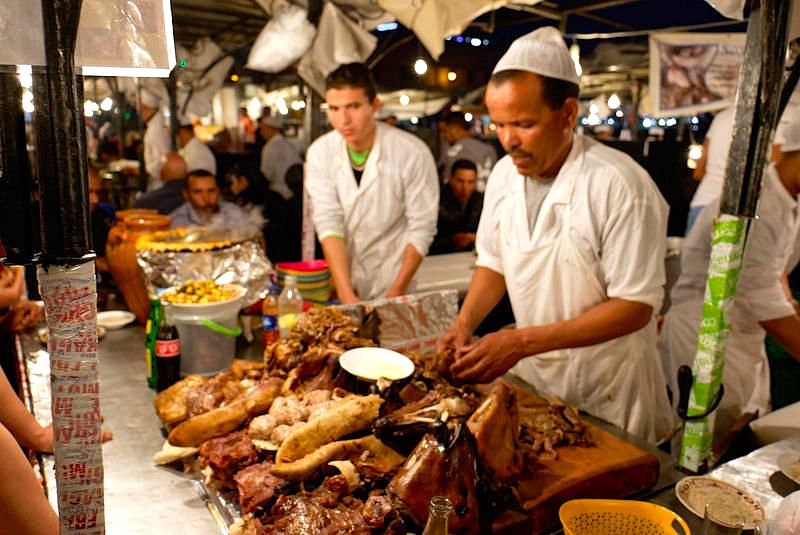Moroccan Cuisine: A Journey Through Flavors, Spices, and Tradition
Moroccan cuisine is a celebration of flavors, colors, and aromas, reflecting centuries of cultural exchange, trade, and culinary innovation. From bustling souks filled with spices to traditional kitchens in riads, every dish tells a story of Morocco’s history, geography, and diverse influences.
At the heart of Moroccan cooking is the artful use of spices, saffron, cumin, cinnamon, paprika, and ginger, blended to create the rich, aromatic flavors that define dishes like tagine, couscous, and pastilla. Fresh herbs, preserved lemons, olives, and seasonal vegetables bring brightness and depth to these traditional recipes, making Moroccan cuisine a feast for all senses.
Beyond taste, Moroccan cuisine is also about hospitality and ritual. Sharing a meal with family or friends is a cherished experience, often accompanied by sweet Moroccan mint tea, bread baked in communal ovens, and storytelling around the table. Each dish is not just food but a cultural experience, connecting travelers to the living traditions of Morocco.
For visitors exploring Morocco through its culinary heritage, tasting the local cuisine is as essential as visiting the medinas, palaces, and deserts. From street food stalls to high-end restaurants, Moroccan cuisine offers something for every palate, combining authenticity, artistry, and sensory delight.
The Signature Dishes of Morocco
Moroccan cuisine is famous for its signature dishes, each offering a unique blend of flavors, textures, and aromas that reflect the country’s diverse cultural heritage. For travelers exploring Moroccan cuisine, understanding these iconic dishes is a delicious way to connect with the country’s culinary traditions.
Tagine: Slow-Cooked Perfection
The tagine is perhaps the most iconic Moroccan dish. Named after the conical clay pot in which it is cooked, tagine combines meats, vegetables, fruits, and spices in a slow-cooking process that allows flavors to meld and deepen. Varieties range from chicken with preserved lemons and olives to lamb with prunes and almonds, each reflecting regional specialties.
Tagines are not only a culinary delight but also a social experience, often served during family gatherings or festive occasions. Visitors can try tagine in traditional Moroccan homes, riads, or local restaurants, offering an authentic taste of Moroccan hospitality.

Couscous: Morocco’s Staple Grain Dish
Another essential component of Moroccan cuisine is couscous. This steamed semolina dish is often served with vegetables, meats, and aromatic sauces, making it a staple at both daily meals and special celebrations. Traditionally eaten on Friday, Morocco’s holy day, couscous brings families together, reflecting the importance of community and tradition in Moroccan food culture.

Pastilla: Sweet and Savory Masterpiece
Pastilla is a savory-sweet pie that combines flaky pastry, spiced meat (often pigeon or chicken), almonds, and powdered sugar. This dish is a symbol of Moroccan culinary sophistication, often reserved for festive occasions. Pastilla exemplifies the Moroccan flair for combining contrasting flavors — sweet, savory, crunchy, and tender, into a harmonious dish that delights both the eyes and the palate.

Street Food and Snacks
Moroccan cuisine is not limited to formal meals. Street food such as b’stilla sandwiches, msemen (flaky pancakes), and harira (hearty soup) offers travelers a quick yet authentic taste of Morocco’s culinary diversity. Visiting markets and street vendors in cities like Fes, Marrakech, and Rabat provides an immersive experience where flavors, aromas, and local life converge.

Spices, Ingredients, and Moroccan Culinary Techniques
The secret behind the vibrant flavors of Moroccan cuisine lies in its spices, fresh ingredients, and traditional cooking techniques. For travelers exploring Moroccan cuisine, understanding these elements provides deeper insight into why each dish is so distinctive and memorable.
Essential Moroccan Spices
Moroccan cooking relies on a harmonious blend of spices that bring depth, warmth, and aroma to every meal. Commonly used spices include cumin, coriander, saffron, paprika, cinnamon, ginger, and turmeric. Spice blends like ras el hanout, a mixture of over a dozen spices, showcase Morocco’s culinary creativity and regional variations. These spices not only enhance taste but also reflect centuries of trade and cultural exchange across North Africa and the Mediterranean.
Fresh Ingredients and Local Produce
Moroccan dishes are rooted in the fresh, seasonal ingredients available locally. Olives, preserved lemons, fresh herbs like coriander and mint, nuts, and a variety of vegetables form the backbone of Moroccan cooking. Meat, typically lamb, chicken, or beef, is used generously in tagines, couscous, and pastilla, while fish is prominent in coastal regions. Markets across Morocco, such as those in Fes and Marrakech, offer travelers an immersive look at these ingredients, making shopping for spices and produce an integral part of the culinary experience.
Traditional Cooking Techniques
Moroccan chefs use a variety of traditional techniques to bring out flavors and textures:
-
Slow-cooking in tagines allows meats and vegetables to absorb spices fully.
-
Steaming couscous ensures a light, fluffy texture that pairs perfectly with vegetables and sauces.
-
Roasting and braising enhance the richness of meat dishes.
-
Layering flavors with sweet, savory, and aromatic elements, as seen in pastilla.
These methods reflect Morocco’s culinary heritage, passed down through generations and still practiced in family kitchens, riads, and local restaurants.
Culinary Storytelling
Each dish in Morocco tells a story, of trade routes, cultural influences, and local ingenuity. Spices like saffron from Taliouine, almonds from Fes, and olives from Meknes reveal the regional diversity of Moroccan cuisine. Understanding these ingredients and techniques enriches any traveler’s journey through Morocco’s food culture, making each meal an educational and sensory adventure.
Moroccan Beverages: Mint Tea, Coffee, and More
No journey through Moroccan cuisine is complete without experiencing the country’s iconic beverages, which complement the flavors of its meals and offer a glimpse into Moroccan hospitality and tradition.
Moroccan Mint Tea: The National Drink
The most famous Moroccan beverage is undoubtedly Moroccan mint tea, also called “Moroccan whiskey” for its central role in social life. Made with green tea, fresh mint leaves, and sugar, it is traditionally poured from a height to create a frothy top, demonstrating both hospitality and ritual. Offering tea is a gesture of welcome, whether in homes, riads, or cafes, and is often accompanied by sweet pastries or nuts.
Coffee in Moroccan Culture
Coffee is another important beverage, influenced by historical trade with the Middle East and Europe. Traditional Moroccan coffee is often strong and spiced, sometimes infused with cardamom or cinnamon. Cafes in cities like Marrakech and Fes offer travelers a space to relax, socialize, and enjoy the bustling street scenes while sipping their favorite brew.
Other Traditional Drinks
Morocco also offers a variety of non-alcoholic drinks that reflect regional flavors and seasonal ingredients:
-
Amlou: An almond, argan oil, and honey spread sometimes paired with tea.
-
Fresh fruit juices: Commonly sold at medina stalls, especially orange or pomegranate juice.
-
Sahlab and other warm milk-based drinks: Popular in winter for their comforting flavors.
Drinking as Cultural Experience
Enjoying Moroccan beverages is about more than taste — it’s about connection, tradition, and ritual. Sharing mint tea in a family home, tasting coffee at a medina cafe, or savoring fresh juice from a market stall allows travelers to experience Morocco’s hospitality firsthand.
By including local drinks alongside historic dishes, visitors gain a full understanding of Moroccan cuisine, from preparation to presentation and communal enjoyment.
Moroccan Sweets and Desserts: A Celebration of Sugar and Spice
Moroccan cuisine is famous for its sweet treats, which are often enjoyed alongside mint tea or as part of festive celebrations. These desserts reflect Morocco’s rich culinary heritage, blending aromatic spices, nuts, and honey into beautifully crafted dishes.
Chebakia: Sesame and Honey Delight
Chebakia is a Moroccan pastry made of thinly rolled dough shaped into intricate patterns, deep-fried, and coated in honey and sesame seeds. Traditionally prepared during Ramadan, chebakia combines sweetness, crunch, and aromatic spices like cinnamon and anise, making it a standout among Moroccan desserts.
Baklava and Almond Pastries
Almond-based pastries, often layered with phyllo dough and honey, are another Moroccan favorite. Influenced by Andalusian and Middle Eastern culinary traditions, these treats highlight Morocco’s skillful blending of textures and flavors. They are commonly served during weddings, religious festivals, and family gatherings, emphasizing the role of desserts in Moroccan hospitality.
M’hanncha: The Serpent Cake
M’hanncha, also called the “serpent cake,” is a coiled pastry filled with almond paste, orange blossom water, and sugar. Its delicate design and fragrant filling make it a visual and culinary delight, perfect for special occasions or as a treat with Moroccan tea.
Cultural Significance of Moroccan Sweets
Sweets in Morocco are more than indulgence; they are symbols of celebration, generosity, and social connection. Whether offered to guests or prepared for festive rituals, desserts like chebakia, m’hanncha, and almond pastries embody the spirit of Moroccan hospitality.
Exploring Moroccan cuisine through its sweets allows travelers to taste the history, culture, and artistry that define this vibrant culinary tradition, completing the experience of Morocco’s rich and diverse gastronomy.
Discover Morocco’s Liquid Gold Today!
Let our experts at Holiday Morocco Tours design a custom culinary journey, from cooking classes and food tours to visits to local markets and traditional restaurants. Discover the flavors, aromas, and stories of Morocco, and create memories that will linger long after your trip.
Don’t just read about Moroccan cuisine — experience it firsthand!
Experiencing Moroccan Cuisine: Cooking Classes, Food Tours, and Markets
To truly appreciate Moroccan cuisine, travelers should go beyond tasting and immerse themselves in the culinary culture through hands-on experiences, guided tours, and visits to local markets.
Cooking Classes: Learn from Local Chefs
Cooking classes in Morocco provide travelers the opportunity to learn traditional techniques, from preparing a tagine to crafting couscous or pastilla. Many classes are hosted in riads or family homes, offering an authentic setting where participants can interact with local chefs, understand spice blending, and practice traditional cooking methods. These experiences make Moroccan cuisine tangible, memorable, and deeply personal.
Food Tours: Discover Hidden Culinary Gems
Food tours take visitors through bustling medinas, spice markets, and street food stalls, highlighting the diversity of Moroccan flavors. Guided by local experts, travelers can taste regional specialties, learn the history behind each dish, and explore culinary customs. Tours often include stops at traditional bakeries, souks, and cafes, making the journey as much about culture as it is about food.
Markets: A Feast for the Senses
Moroccan markets, or souks, are a sensory wonderland where spices, fresh produce, olives, nuts, and sweets fill the air with vibrant colors and aromas. Visiting markets in Marrakech, Fes, and Rabat allows travelers to connect with local vendors, understand ingredient sourcing, and even pick up fresh herbs or spices to bring the taste of Morocco home.
Culinary Travel as Cultural Exploration
Engaging in cooking classes, food tours, and market visits transforms dining into a cultural adventure. Travelers not only enjoy the flavors of Moroccan cuisine but also gain insight into traditions, hospitality, and daily life, making each meal a story and each dish a connection to Morocco’s rich heritage.
Experiencing Moroccan cuisine firsthand allows travelers to fully appreciate its complexity, diversity, and cultural significance, creating memories that go far beyond the plate.
Taste Morocco: A Culinary Journey You Can’t Miss
Moroccan cuisine is more than just food, it is a window into the country’s history, culture, and traditions. From the aromatic tagines and hearty couscous to the delicate pastilla and sweet treats like chebakia, each dish tells a story of Morocco’s rich culinary heritage. Pair these flavors with Moroccan mint tea, explore bustling souks, and enjoy the artistry of traditional cooking for a truly immersive experience.
Don’t just read about Moroccan cuisine, experience it firsthand. Let our experts at Holiday Morocco Tours design a custom culinary journey, from cooking classes and food tours to visits to local markets and traditional restaurants. Discover the flavors, aromas, and stories of Morocco, and create memories that will linger long after your trip.
